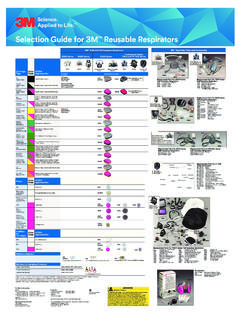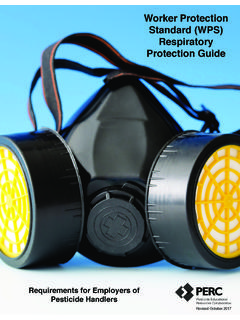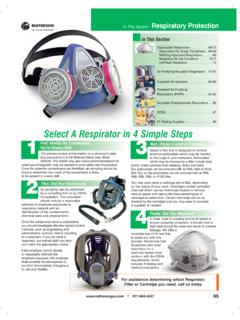Transcription of The Gold Standard In Respiratory Fit Testing
1 The GoldStandard InRespiratory Fit TestingTMQuantitative respiratorfit Testing is a practicethat has been aroundsince the late 1960 there have beenseveral ways in whichto perform a respiratorfit test, there werenever any scientificstudies to prove thatthese methods actuallyworked. These tech-nologies have simplybeen accepted because they werethe only way to do quantitative fittesting. The technology seemed tomake sense, and at least it was bet-ter than nothing at all. Or was it?Things changed in 1992 when theidea of Controlled NegativePressure (CNP) was implemented ina whole new approach to fit test-ing. This revolutionary way to per-form a respirator fit test could besubjected to scientific scrutiny. Theresults? Unlike all other methods offit Testing , Controlled NegativePressure was proven to quickly andaccurately measure respirator leak-age, which is the key to measuringrespirator fit. CNP technology was accepted byOSHA in 1998, and has quicklybeen adopted by industry to bethe quickest and most accurateway to perform respirator fit test-ing the gold Standard in respira-tor fit old technologies are some-times hard to give up because, we ve just always done it thatway, the OHD Quantifit offers animpressive array of advantages thatcan dramatically improve your res-pirator program.
2 Within the first tenseconds of Testing , you will knowwhether the respirator user has abasic fit or not. And the OSHA-accepted CNP Redon protocol takesas little as two to three minutes. Ifother quantitative fit test instru-ments measured accuracies of lessthan 40%1, why put your employeesat risk? Controlled negative pressure hasproven to be the fastest, most accu-rate, and most health protective fittest system available. The acceptedRedon test protocol allows you toquickly assess respirator fit basedon three mask donnings. Given theQuantifit s speed and accuracy inmeasuring actual respirator leak-age, why would you subject youremployees to something that is lessthan the best? gold Standard in respirator Fit TestingHere s how theQuantifit a fit test, the respira-tor inlets are capped withtest adapters, and theinhalation valves areremoved from the the test subject holdinghis or her breath for nomore than ten seconds, theQuantifit then establishesand maintains a slight vacu-um, or controlled nega-tive pressure, inside themask.
3 Since the respiratorinlets are sealed, all sourcesof leakage into the maskare through the face-to-facepiece seal. The volumeof air drawn out of themask by the Quantifit dur-ing this short period of timeis equal to the leak rate intothe mask through the face-to-facepiece s that Proven TechnologyTheOHD Quantifit is a highly spe-cialized instrument which utilizesthe scientifically-proven andpatented CNP (ControlledNegative Pressure) technology todirectly measure respirator leak-age. The OHD Quantifit isaccepted by OSHA and appearsin the Federal Regulations gov-erning fit Testing [29 ]. The Quantifit is alsoincluded in the CanadianStandards [CSA ] andUK HSE standards [EN132-149]. Fastest Fit TestingAvailableWith the OSHA-approved CNP REDON respiratorfit test protocol, a fit test can beperformed in as little as 2-3 minutes and there is no waitingperiod for smokers as requiredwith other fit test methods. TheREDON protocol uses CNP tech-nology s superior speed andaccuracy to help achieve the bestrespirator fit possible.
4 The multi-ple donnings required assuresthat the worker knows how todon the respirator correctly witheach use. Most Health ProtectivePeer-reviewed, scientific studieshave shown that the OHDQ uantifit produces much moreaccurate, more health protec-tive, and more believable testresults than other systems. Instudies where a known calibrat-ed respirator leak is present, theOHD Quantifit measured 98%of known calibrated leak. Theaerosol-based system measuredonly 37% of known calibratedleak1. Easy to UseThe Quantifittakes the user through the testprotocol step-by-step so thatthere is no guess-work, and notime needed to pre-instruct theemployee being tested. There isno instrument warm-up period toworry about, and the one-minutedaily calibration assures that theQuantifit is working within a stricttolerance. Ease of use means lessmistakes, and quicker Testing . Most Rigorous TestThe useof ambient air as a Standard (non-varying), gaseous challengeagent provides a more rigoroustest of mask fit than does anaerosol agent.
5 If air leaks into arespirator, there is a chance thatparticles, vapors, or gas contami-nants may leak in. When usingaerosol-based systems, the testsystem can only see and meas-ure someof the particles thatmightenter the respirator . Direct Measurement ofLeakThe Quantifit directlymeasures facepiece are no specific conditionsor environmental concerns whentesting with the OHD unit precisely measures leakrate (in cc/min) by determiningthe amount of air that leaks intothe respirator during the fit test. NIST CalibrationThe abilityto calibrate the Quantifit withgenerally available primary cali-bration systems assures a higherstandard of test results (NIST traceable Standard ). On-board SoftwareNotonly does the on-board softwareallow the Quantifit to beextremely flexible, but all updatescan be achieved through a flash-upgrade. Users can downloadsoftware from the internet andeasily upgrade the Quantifit toassure the lastest and most up-to-date version. On-board StorageTheQuantifit can hold more than1,000 fit test records.
6 Theserecords can later be transferredto the included FitTrack softwareon your personal computer. Keyboard InterfaceTheQuantifit can use a keyboard toinput data into the local allows the user to input anemployee s name and ID num-ber, as well as the respiratorinformation. Keyboard input iseasier and quicker than touch-screen or other input methods. USB Computer InterfaceThe Quantifit can be directly con-nected to a computer to operatethrough FitTrack Software. Thisgives the user more control andadvanced record keeping oppor-tunities. All test results may betransferred to the FitTrack soft-ware. USB Memory StickInterfaceWhile data can betransferred to a PC via the USBconnection, one may also trans-fer data via a USB memory interface may also be usedto update the software in theQuantifit. USB HP PrinterThis printerconnection allows for tests to beprinted directly from theQuantifit, without the need for apersonal computer. Optical Encoder KnobThe navigational knob on theQuantifit allows for fast andintuitive navigation through themenus on the instrument.
7 Thiswill more quickly bring youdirectly where you choose to go. Tilted Backlit DisplayThedisplay can be adjusted for anylighting situation, and is tilted foroptimum viewing whether theoperator is standing or sitting. Universal Power Cord Thepower cord for the Quantifit willadjust to the proper voltageregardless of the country in whichthe Testing is being end user will simply swap outthe prong configuration to inter-face with the local settings. Flexible DataManagement SoftwareWhile the OHD Quantifit can beused as a stand-alone unit,FitTrack software allows for easytesting and dependable recordkeeping through a personal com-puter. FitTrack can print individ-ual reports or summary reports inmany configurations. Data canbe imported and exported tomeet various & Benefits1C Crutchfield, D Park, Effect of Leak Location on Measured respirator Fit, Am. Ind. Hyg. Assoc. J. 58:413-417, Test Model ParametersEquivalent Fit Factors are calculated from actualmeasured respirator leak rates, based on thefollowing modeled test parameters which areuser selectable:Inspiratory Work RateMeasurement of energy expended by testsubject in the normal working environ-ment; indicated in thousands of caloriesper hour (K-Cal/hr).
8 Selections include 100 (light activity)200 (moderate activity) 300 (heavy activity) and 350 (extreme activity) Mask TypeSelections for full-face or half mask respi-rator TypeSelections for low, medium, or high densi-ty cartridge types. Subject GenderSelections for male & female test choices affect modeled CNPchallenge pressure choices affect modeled respira-tory inspiration RangeLeak Test Measurement2 5000 cc/minFit Factor Computation6 53,000 Resolution1 Pressure Sensor ParametersPressure Range0-20 inches inch H2 OAccuracy FSOver-Pressure Limit60 inches H2 OTemperature compensation15 30 CelciusInstrument AccuracyChallenge Pressure 5 %Leak Rate Measurement 3% or 3 cc/min, whichever is greaterDisplayLCD Graphical 128 X 64 PixelsUSB InterfaceDual Type A Ports Supports Keyboard, HP Inkjet printer, or memory stickSingle Type B PortFor connection to PCSetup MemoryEEPROM, All ParametersData Retention10 Years w/o PowerRTC, Datalog MemoryRechargeable BatteryData Retention6 Months w/o PowerOperating Range15 to 30 Degrees CStorage Range-40 to 60 Degrees CConstructionEnclosure Polyethylene Plastic Chassis 1/8 Aluminum, Face Lexan, Back x 10 x x x mm(HxWxD)
9 Weight< lbs. ( kg)ConnectionsPressure: Quick Connect, Vent: Female Luer Trigger Button : Phono JackPower Source100 240 VAC, 50/60 HzPower Supply Adapter9 VDC, 5000 mA Power ConsumptionLess than 1000 mACertificationsUL, CE, CSAW arrantyInstrument CoverageTwo-Years Parts and SupportFree telephone technical support to originalowner of AccessoriesHard case with roller wheels and retractable handleUSB KeyboardPower CordTrigger ButtonTriple Tube AssemblyPC USB CableFitTrack Software Operator s ManualOptional AccessoriesFit Test respirator AdapterUSB PrinterFit Test Card Laminator KitExtended WarrantyPrepaid Service AgreementOptional respirator Fit Test Adapters3M CompanyBacou/DallozDraegerGlendaleIntern ational Safety Safety AppliancesMoldexNorth SafetyProtechScottSperian (formerly Survivair)US SafetyCall for information on additional respiratormanufacturers & SoftwarePC RequirementsPentium 133 MHz or betterRAM64 MB or greaterOperating SystemWindows 2000, XP, or VistaDigital InterfaceUSB PortDisc Space25MB minimumPrinterAny Windows-compatible printerQuantifit Specifications197 Cahaba Valley ParkwayPelham, AL 35124 Local: (205) 980-0180 Toll Free: (888) 464-3872 Fax: (205) 980-5764 Web.






